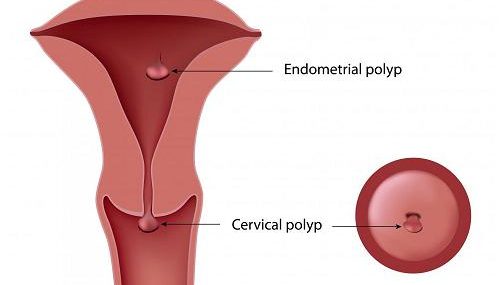Adenomatous polyps (cervical or endometrial polyps)
What are uterine polyps and what does adenomatous polyp mean?
Adenomatous polyps (Uterine polyps) are tumor growths affecting the endometrial lining of the uterus or the inner wall of the uterus that extends into the uterine cavity. Cervical and endocervical polyps are the most common benign, neoplastic polyps that usually cause postcoital bleeding and dyspareunia (painful sexual intercourse), whereas endometrial polyps often cause spotting (light vaginal bleeding or bleeding a few drops of blood). Endometrial polyps need no further treatment after diagnostic curettage, but patients must be observed for recurrence. Cervical polyps have a higher tendency to develop into invasive cancers and thus need further diagnostic evaluation. More than 80% of uterine polyps are adenomatous.
How common are adenomatous polyps?
Adenomatous polyps are the most common benign disorders affecting the uterus and causing postmenopausal bleeding.
Adenomatous polyps are very common among women and girls ages 29-59. However, the frequency of asymptomatic polyps in postmenopausal women is about 10%.
Symptoms
What are the symptoms of uterine polyps?
Abnormal vaginal bleeding or spotting that persists longer (intermenstrual bleeding, and metrorrhagia), which is characterized by a small amount of vaginal discharge that is mainly composed of blood rather than clear or heavy bleeding. Other symptoms include:
- Postmenopausal vaginal bleeding
- Menorrhagia or heavy prolonged menstrual periods
- Postcoital bleeding, mainly comes from cervical polyps
- Infertility
- Irregular menstrual bleeding
- Dyspareunia
Causes
What causes uterine polyps?
Uterine polyps (endometrial polyps) are often associated with glandular endometrial hyperplasia in the background of neuroendocrine syndrome, other risk factors include:
- Obesity
- Diabetes
- Hypertension
- Atypical hyperplasia of the endometrium
- Repeated infections especially HPV infection
What are the chances of uterine polyps being cancerous?
Uterine polyps (endometrial polyps) are benign neoplasms or tumors; However, Around 5% of uterine polyps are precancerous or cancerous, especially in postmenopausal women taking tamoxifen, or in women with menorrhagia.
Treatment
How to treat endometrial polyps and how to remove uterine polyps?
What is a hysteroscopic polypectomy?
Hysteroscopy is a gold standard procedure used to remove the endometrial polyp and to restore the uterus to normal. Hysteroscopic polypectomy or the hysteroscopic removal of an endometrial polyp is an outpatient procedure performed under local anesthesia and sedation, in which a polyp can be removed under direct hysteroscopic visualization without affecting other parts of the endometrium.
How long does it take to get over a hysteroscopy?
Hysteroscopy usually takes less than an hour to complete. Pain and discomfort after surgery is normal; however, discomfort and pain usually subside within 24 hours.
What is a dilation and curettage procedure?
Dilation and curettage (D&C) is a procedure in which the cervix is dilated and the entire lining of the uterus and/or uterine content is removed surgically by means of a curette, but if the polyp persists after a repeated curettage it must be removed by radical surgery (hysterectomy).
Hormone therapy may also be helpful (a progestin); However, hormone therapy is not recommended for the treatment of adenomatous polyps because in most cases it will not resolve the issue.
What is a cryosurgery in the cervix?
Cryosurgery is commonly used for the treatment of adenomatous polyps, cryosurgical treatment of the polyp bed results in the normalization of the endometrial estrogen receptor apparatus and prevents polyp relapses (the regrowth of polyps) in 90% of cases.
Next steps management
How to diagnose uterine polyps?
- General clinical examination
- Pelvic ultrasonography (a transvaginal ultrasound) is a diagnostic test commonly used in the mid portion of a cycle (around the time of ovulation) to reveal endometrial changes and abnormalities, such as endometrial thickness, polyps, etc.
- Colposcopy is a procedure in which the doctor uses a colposcope to examine your cervix, vagina and vulva
- HSGs or hysterosalpingograms are procedures used to reveal abnormalities within the uterus, such as polyps, fibroids, adhesions, or a uterine septum.
- Symptomatic therapy, this involves the use of prolonged synthetic progestins
- A radical surgical procedure should be performed if histological examination after a repeated curettage shows that the adenomatous polyp was not removed.
References
Verified by: Dr.Diab (November 7, 2017)
Citation: Dr.Diab. (November 7, 2017). Adenomatous Polyps Symptoms Causes and Treatment. Medcoi Journal of Medicine, 10(2). urn:medcoi:article15632.














There are no comments yet
Or use one of these social networks